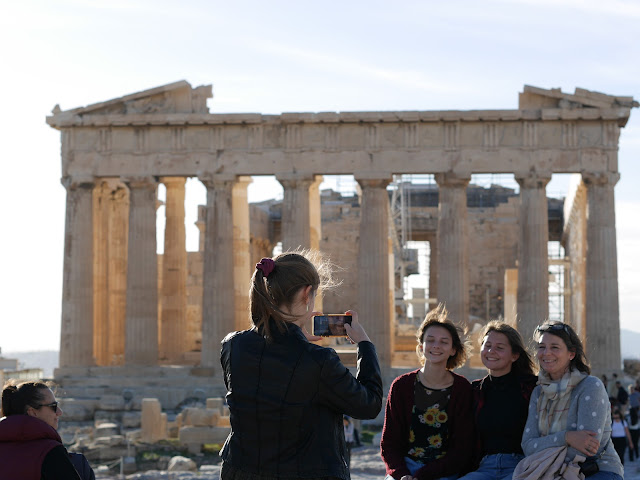In one of his letters, Freud describes a trip to Athens with his brother. Upon seeing the Holy Rock he said he remembered thinking, "So this all really does exist, just as we learned in school!" He went on to explain that he never disbelieved the existence of the Acropolis, but that he did doubt he would ever see it in person. "There was something dubious and unreal about the situation."
Sing it, my man. At least twice on this trip I have turned to a stranger and said, "I can't believe I'm here." There is a shared exuberance on the hilltop. People skip with joy, handing their phones to strangers, hoping for a perfectly framed photo. Often, the picture-taker will return the request: "Now do me!" I noticed a similar giddiness among visitors at the Baalbek ruins. Maybe it has to do with the colossal nature of these monuments. They are not relatable on a human scale, leaving us a bit dizzy.
There are many ways to attack Acropolis Hill, but for centuries, visitors wishing to reach the summit temples have had to enter and exit through the Propylaia.
The buildings that dominate Acropolis Hill today ― the monumental Propylaia entranceway, above, the Parthenon, the Erechtheion, and the Temple of Athena Nike, were all erected in the 5th century B.C. on the initiative of Pericles. Of course, the site underwent a lot of changes from the birthplace of Christianity through Frankish and Ottoman rule, but the fact there are only four major structures at the top makes it easy to understand for simple guys like me. Above all, I wanted to see the Erechtheion's Porch of the Maidens to see how it may have looked in 430 B.C.
The female figures serve as architectural supports, making them caryatids. Granted, they are replicas. The originals are in the Acropolis Museum, and, painfully for Greece, one is in the British Museum. "Bring her back" is a common refrain here. The Greeks would also like the Parthenon sculptures known as the Elgin (hard "g") Marbles returned. Britain says they were legally obtained from the then-Ottoman rulers of Greece, but there's no paper trail to prove that. And on it goes. A kindergartner could explain what needs to happen next: Britain should hand over the "Lost Sister" and the Marbles to Greece. Germany should return the Nefertiti bust to Egypt. And for good measure, let's give Ireland back to the Irish. This isn't hard.
On the south slope is the Dionysus Theater, where the tragedies and comedies of Aeschylus, Sophocles and Euripides were first performed. Some of the front-row seats are engraved for special patrons. My dear old mum and dud have have a similar cachet at the local playhouse.
The sun sets on central Athens, its footprint spilling out to the northeast. That's pine-covered Lykavittos Hill at right.
To me and the 60 other people up here on a windy late afternoon, the setting sun means it is time to earnestly snap photos of the Parthenon.
Let's not waste our time chatting about it: No other structure on earth has had a greater influence on Western architecture ― Western civilization for that matter. You go ahead; I have nothing to add other than that restoration work is taking place on the west pediment.
A kid shows me his sketches of the caryatids. Stay in school. (I'm joking. These are cool.)
The Temple of Athena Nike (the goddess of victory). To Phil Knight's chagrin, the Greeks pronounce her name "Nicky."
In an evening ritual, soldiers come to lower the national flag.
We exit through the Propylaia. At 0:21 seconds is a good view of the Temple of Athena Nike's north face. And the flag is returned to its resting place. For as long as I have been here, the evening sky has had a lovely softness, like an 18th-century painting. An "orange-fingered dusk," if Homer will allow it. It is good to be alive.















Comments
Post a Comment